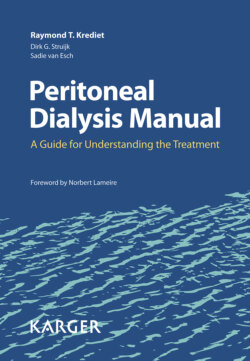Читать книгу Peritoneal Dialysis Manual - R.T. Krediet - Страница 6
На сайте Литреса книга снята с продажи.
Foreword
ОглавлениеDuring the 40 years of my career in academic nephrology, there were many opportunities and occasions for meeting and establishing long-time friendships with many colleagues in nephrology. In particular during my tenure as Editor-in-Chief of Nephrology Dialysis Transplantation and Chair of the International Society of Nephrology (ISN) Continuing Medical Education Program, I was and still am so fortunate to be part of this global nephrological community. Outstanding among these relationships is the long-term and highly esteemed friendship with Prof. em. Raymond “Ray” Krediet of the Academic Medical Center, University of Amsterdam.
My first “official” meeting with Ray was somewhat “uneasy” because I was invited by the Faculty of Medicine of the University of Amsterdam to be the “extra muros” jury member of Ray’s PhD thesis, which was devoted to one of the first in-depth pathophysiological investigations on peritoneal transport and its various clinical aspects. Since it is expected from an “extra muros” opponent jury member to ask at least one or two intelligent questions during the public defense, I remember my great difficulty in formulating these questions because Ray’s work was already at that time (1986) thorough, original, and reflected highly intelligent planning. Since then I have increasingly admired the logical continuation of the peritoneal dialysis (PD) research program by many brilliant young collaborators inspired and supervised by Ray during all the subsequent years. In this way, an internationally recognized and highly esteemed “true PD school” has established in Amsterdam.
Our understanding of the anatomy and physiology of the peritoneal membrane has tremendously increased over the years, and the advantages of PD in the overall management of end-stage kidney diseases became better realized. It became clear that the patient outcomes are comparable to and more cost-effective than those with hemodialysis. These benefits have, however, not led to increased PD utilization. Although PD is a valid renal replacement therapy when incorporated in an overall integrated care program for the patient suffering from end-stage renal disease, it has not yet established as a true long-term dialysis modality. The variable trends in PD use reflect the multiple challenges in prescribing this therapy to patients, and although its use is increasing in some countries, including China, the USA and Thailand, it has proportionally decreased in parts of Europe and Japan. Key strategies for facilitating PD utilization include the implementation of policies and incentives that favor this modality, enabling the appropriate production and supply of PD fluid at a low cost, and, very importantly, appropriate training for nephrologists and other renal care providers. I believe that in addition to the training of nephrologists, greater efforts should be made to improve the basic knowledge of PD in other medical fields, including general practices and other nonnephrological health care. Very often the patient in need of initiating dialysis will seek advice from his general practitioner or family doctor, a renal nurse, or a social worker on the different modalities of renal replacement therapy. Indeed, nurses play a vital role in patient choices by providing accurate information backed up by world-class research to patients about the potential benefits of PD. Lack of familiarity with PD of these health care providers unavoidably leads to biased advice to their patients. It is believed that part of the gap between the desired and the observed modality mix of renal replacement therapies, for example in Europe, may be due to suboptimal information provision to patients, and patient surveys have revealed that there is an association between the involvement in modality selection and patient satisfaction.
The present booklet, entitled Peritoneal Dialysis Manual: A Guide for Understanding the Treatment, written by Ray T. Krediet, Dirk G. Struijk, and Sadie van Esch, meets the need for a practical handbook offering sensible advice but also detailed information on virtually all clinical and pathophysiological aspects of PD in a readily accessible format. The easy, small format should fit in a white coat pocket of a nephrologist or resident in nephrology and internal medicine seeing a PD patient during rounds or in the outpatient ambulatory setting. This book should, however, also be of relevance, use, and interest to all other health care workers involved in the treatment of patients suffering from end-stage renal disease – nurses, pharmacists, dieticians, intensivists, and medical students. The fact that the majority of the chapters are written by a single author able to explain the complexities of PD in a clear but still scientific and comprehensive way is one of the attractive aspects of this work. I recommend this booklet since I am convinced that it is an excellent addition to the PD library in every renal unit worldwide.
Norbert Lameire, MD, PhD
Emeritus Professor of Medicine and Nephrology
Medical Faculty of the University of Ghent, Belgium
